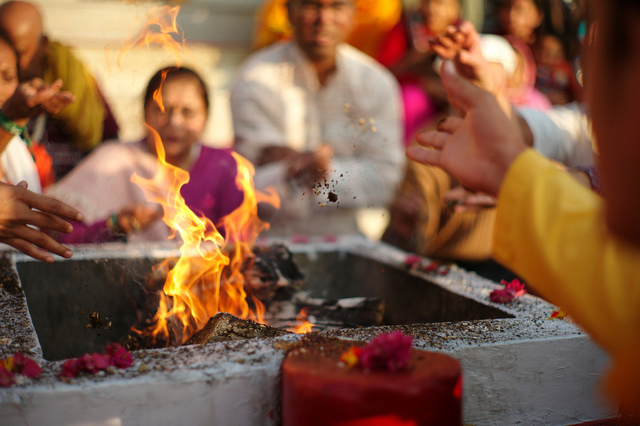The Fourth Aim: Moksha Our investigation of the four Purusharthas, or aims of life in the Vedic tradition, concludes with Moksha, which means release, liberation or self-realization. The harmonious interactions of the first three aims, Dharma, Artha and Kama, are the...
New to Yoga
Practices
Yoga in Your Daily Life
Yoga Beyond Asana
Sister Sciences »
Our Sangha »
Jyotish
The Four Purusharthas: Kama
The Third Aim: Kama As our investigation of the Purusharthas continues, we come to the third aim, Kama, which means longing, wish, or desire. Kama pertains to the enjoyment of life and needs to be in balance with Dharma (duty) and Artha (means) if we are to experience...
Sankalpa and the Power of Mars
By Gwen Burdick In Yogic philosophy, when the intention of the heart and intention of the mind merge with resolve and determination in search of Truth, we have what is called Sankalpa in Sanskrit, or solemn vow. “Kalpa” means vow and “san” means truth. It refers to...

The Vedic Fire Ceremony
Fire, or Agni in Sanskrit, is one of the five basic elements of creation. It dominates the Pitta dosha of Ayurveda. In its highest expression, Agni is the source of self-discipline, purification and transformation.
The Myth of RAHU and KETU: the Lunar Nodes
In Vedic Astrology, Rahu and Ketu are the important Lunar Nodes. Unlike the seven visible planets, Grahas in Sanskrit, they are massless yet potent mathematical points in space, sometimes referred to as the shadow planets. Our solar system is structured such that it...
Sister Sciences: Ayurveda and Jyotish
The purpose of the Vedic sciences is to promote Self-realization, and the spiritual disciplines of Ayurveda and Jyotish, Vedic Astrology, share their ancient roots. Ayurveda, which means knowledge of Life in Sanskrit, provides regimens to harmonize the mind/body...
Surya
"The Moonbeams are also the rays of the Sun." - the Vedas Our Sun, Surya in Sanskrit, is the 4.5 billion year old yellow dwarf star at the center of our solar system. It is an almost perfect sphere of gas (mostly Hydrogen and Helium) 860,000 miles in diameter and...
The Distant Stars
By Gwen Burdick The billions of years old and never-changing distant stars visible in the night sky make up the circle that mankind has observed and described as the zodiac. Vedic Astrology, Jyotish in Sanskrit, divides the 360 degree sky into 27 stellar...
Looking Ahead in 2019
Vedic Astrology, Jyotish in Sanskrit, is a sister science to Yoga and Ayurveda. It is the study of the precision of our solar system and planetary movements that create linear chronological time. Comprehension of this ancient wisdom tradition allows for the awareness...
The Eclipse Cycle – by Gwen Burdick
A concentration of energy occurs twice a year on average as the Sun, Moon, and Earth line up in space, creating solar and lunar eclipses. Solar eclipses take place on the New Moon and lunar eclipses on the Full Moon, always two weeks apart. They are events when the...
What Time Is It? The Vedic Sky: Gwen Burdick
Most people today look to the Gregorian calendar or even their smart phone for an awareness of the passage of time. Whether or not skilled in time management, most of us can feel the pressure of the unfolding of time. Sunrises, sunsets and the lunation cycles are the...
Auspicious 108
The number 108 is considered an auspicious, or sacred, number. For this reason there are 108 beads on a japa mala, or prayer garland. It is why many people do 108 sun salutations on summer and winter solstice. During our chanting for peace at The Yoga Sanctuary this...
